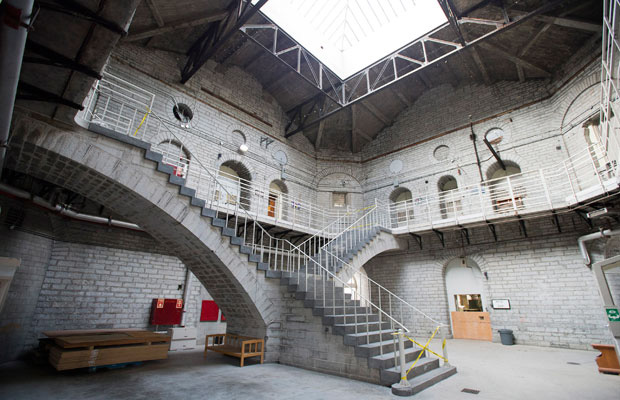
Kingston Penitentiary
Kingston, Canada West
It is about three years ago that I paid a visit with my husband to the Penitentiary, and went over every part of it. I must own that I felt a greater curiosity to see the convicts than the prison which contained them, and my wishes were completely gratified, as my husband was detained for several hours on business, and I had a long interval of leisure to examine the workshops, where the convicts were employed at their different trades, their sleeping cells, chapel, and places of punishment. The silence system is maintained here, no conversation being allowed between the prisoners. I was surprised at the neatness, cleanliness, order, and regularity of all the arrangements in the vast building, and still more astonished that forty or fifty strong active looking men, unfettered, with the free use of their limbs, could be controlled by one person, who sat on a tall chair as overseer of each ward. In several instances, particularly in the tailoring and shoemaking department, the overseers were small delicate-looking men; but such is the force of habit, and the want of moral courage which generally accompanies guilt, that a word or a look from these men was sufficient to keep them at work.
The dress of the male convicts was warm and comfortable, though certainly not very elegant, consisting (for it was late in the fall) of a thick woollen jacket, one side of it being brown, the other yellow, with trousers to correspond, a shirt of coarse factory cotton, but very clean, and good stout shoes, and warm knitted woollen socks. The letters P.P. for “Provincial Penitentiary,” are sewed in coloured cloth upon the dark side of the jacket. Their hair is cut very short to the head, and they wear a cloth cap of the same colours that compose their dress.
The cells are narrow, just wide enough to contain a small bed, a stool, and a wash-bowl, and the prisoners are divided from each other by thick stone walls. They are locked in every night at six o’clock, and their cell is so constructed, that one of the keepers can always look in upon the convict without his being aware of the scrutiny. The bedding was scrupulously clean, and I saw a plain Bible in each cell.
There is a sort of machine resembling a stone coffin, in which mutinous convicts are confined for a given time. They stand in an upright position; and as there are air holes for breathing, the look and name of the thing is more dreadful than the punishment, which cannot be the least painful. I asked the gentleman who showed us over the building, what country sent the most prisoners to the Penitentiary? He smiled, and told me “guess.” I did so, but was wrong.
No, said he; “we have more French Canadians and men of colour. Then Irish, English, and run-a-way loafers from the States. Of the Scotch we have very few; but they are very bad–the most ungovernable, sullen, and disobedient. When a Scotchman is bad enough to be brought here, he is like Jeremiah’s bad figs–only fit for the gallows.”
Susanna Moodie, Life in the Clearings (1853)